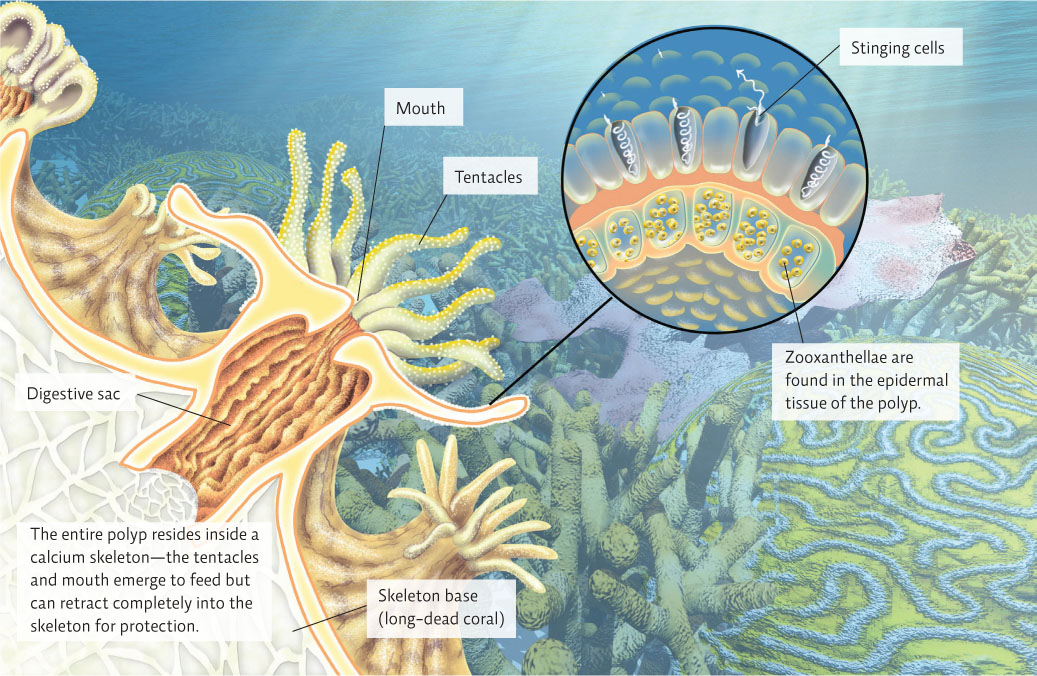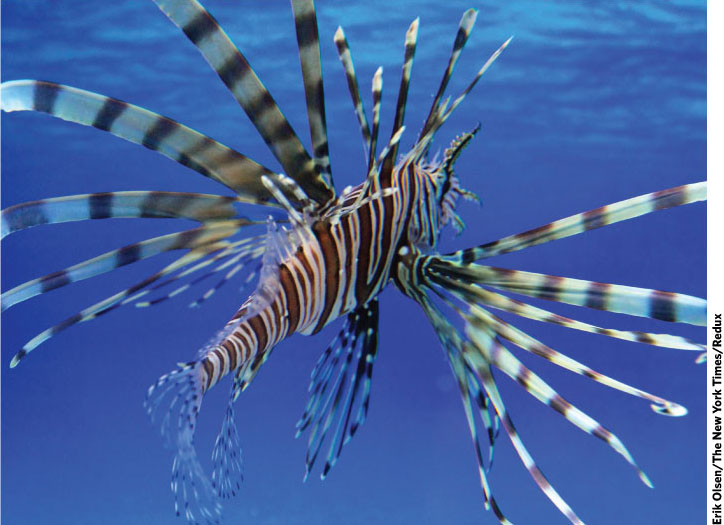Coral reefs are complex communities with lots of interspecific interactions.
Species of tropical coral reef communities interact with and depend on each other in many ways (see Chapter 10). Clownfish and sea anemones offer each other both food and protection (mutualism); remora fish attach their suckers to manta rays and eat any bits of food that flow out of a ray’s mouth (commensalism); and sea urchins act like lawn mowers, feeding on the reef itself in a way that enables new corals to attach and grow, thereby keeping the overall structure strong and healthy.
Like kelp, coral reefs attract and provide food and habitat for many other species. In fact, scientists estimate that 25% of all ocean species spend at least some portion of their life in a tropical coral reef. This outsized role in marine ecology makes reefs an appealing target for oceanographers to study and is but one of several reasons that the Aquarius station was positioned near a reef. “Coral reefs are the ultimate keystone species,” says Martens. “Understanding them is the key to understanding everything else that’s going wrong in the ocean right now.”
29-13
Corals are tiny marine organisms that live in densely packed colonies of many individual polyps; a polyp is basically a tube with one opening surrounded by tentacles. Coral larvae (immature stage) are free floating but must attach to a surface to survive. Established coral reefs actually attract the larvae via chemical cues, increasing the odds that the larvae will attach to and build on top of existing coral skeletons. Once attached to a surface, the larvae enter the polyp stage and secrete a calcium carbonate skeleton. A reef thus grows from corals building on top of other corals over the course of generations. Studies have also shown that lower pH leads to declines in fertilization, in larval development, and in a process called settlement—the dropping of coral larvae out of the water column and their attaching to something solid—the necessary prerequisites to new coral colony formation.
Corals feed on decaying organic material and plankton—pretty much anything that floats by. But they live in nutrient-poor regions: Tropical waters tend to remain stratified, with warm water trapped above colder, deeper water. This stratification prevents the mixing of deep water and surface water that would normally bring up nutrients from below.
29-14
KEY CONCEPT 29.5
Corals depend on a mutualistic relationship with zooxanthellae; the zooks provide food (and color) to the corals, and the corals provide habitat, CO2, and food to the zooks.
Thus the corals themselves could not survive without some help from their algal partners. They live in a mutualistic relationship with zooxanthellae (known affectionately to marine biologists as “zooks”)—a photosynthetic, dinoflagellate algae (a protozoan) that lives inside, and shares nutrients with, the coral. Corals provide their resident zooks with nutrients (from the polyps’ waste) and CO2 for photosynthesis. Zooks, in turn, provide the coral polyps with food (sugars made during photosynthesis provide up to 90% of the coral’s energy needs). In addition, the zooks give the corals their beautiful colors. The barrel sponges Slattery studies also have a mutualistic relationship with a resident photosynthetic partner—cyanobacteria rather than the zooxanthellae found in coral; the sponge provides safe habitat and nutrients to the cyanobacteria, which in return provides sugars to the sponge. Both of these are well-honed evolutionary collaborations that enable each species to thrive in a nutrient-poor environment. INFOGRAPHIC 29.5
CORAL BIOLOGY
Coral live in a mutualistic relationship with zooxanthellae (“zooks”)—photosynthetic algae-like protozoa that live inside the epidermal cells of the coral. The two species share nutrients. Zooks also raise the pH of the coral cells slightly, which helps the coral lay down its coral skeleton. Though they come in a tremendous variety of shapes and colors due to species differences and even growing conditions, all coral have the same basic body plan: the polyp—a tube-like structure attached at the base to a substrate. At the top of the tube are stinging tentacles that trap food floating by, which is taken in by the mouth and sent to the digestive sac.


Are coral plants (producers) or animals (consumers)? Explain.
Coral are animals. As adults they are stationary, attached to the ocean floor by their calcium-carbonate shell, but they consume other organisms and digest their prey like other animals (consumers). They do contain a symbiotic partner, photosynthetic zooxanthellae, but this does not make them a producer. The coral polyp itself still obtains its nutrients from an outside source and is thus classified as a consumer.
Corals can control the number of zooks they host in their cells by adjusting the amount of sunlight or nutrients they supply. Under extreme stress, such as pollution, salinity changes, low pH, or—the main stressor—temperatures that are too high, corals have been known to expel the algae. This event is known as coral bleaching because when it happens, the coral turns bone white. Though the corals can survive for a short period of time without zooks, they will die if not recolonized within several weeks or, at most, a few months. Bleaching may be a way to withstand a short-term stress or even allow the coral to recolonize its tissues with different species of zooks that are better suited to the new conditions. But even if the coral survives a bleaching event, its reproductive success may be reduced, and it may be less hardy overall, making it more vulnerable to further stresses. Since the many species of zooks are symbiotically tied to their coral hosts, any events that lead to coral death, such as bleaching or decalcification, could also lead to the loss of the zooxanthellae species that reside in those coral. INFOGRAPHIC 29.6
coral bleaching
A stress response in coral in which the mutualistic algal partner is expelled; this weakens and can even kill the coral if it is not recolonized soon.
CORAL BLEACHING
Coral may expel their zooxanthellae if stressed, such as when water temperature gets too high (though the mechanism for how this expulsion occurs is poorly understood). Without their pigmented algae, the white coral skeleton can be seen through the translucent polyp—leading to the term “coral bleaching.” Bleaching may be an adaptation that allows the coral to take up a different species of zooks, one that can tolerate the warmer temperatures, for instance. Coral may be able to survive for a few months without the zooks but if the polyps don’t eventually take other algae back up, they will die. Multiple warming events or a warming event that persists for several weeks may stress the coral beyond its ability to survive. Pollution and even excess sun exposure are also linked to bleaching events.
Bleached staghorn coral on a Fiji reef

Tim Laman/National Geographic Stock

Are bleached coral dead?
Not necessarily. It might be a temporary situation and if the coral can be recolonized by zooks, the coral may recover. But if the coral polyps go too long without zooks, they will die so some bleached coral in the ocean may indeed be dead.
29-15
KEY CONCEPT 29.6
When stressed, corals may expel their zooks, resulting in bleaching; if they are not recolonized soon, the corals will die.
Scientists have found that in the past, corals have gone through natural death and birth cycles in response to environmental changes such as shifts in temperature or pH. However, many scientists feel that today’s accelerating rates of acidification and bleaching are likely unprecedented, as is their global scope.
29-16
